The Bagpipe Society
Giovanni Lorenzo Baldano's sordellina manuscript of 1600: a new approach to reconstruction
Giovanni Lorenzo Baldano’s sordellina manuscript of 1600: a new approach to reconstruction by Peter Walker
Giovanni Lorenzo Baldano (1576-1660) was a poet and magistrate from the Northern Italian town of Savona¹. A song either collected or composed by Baldano was quoted in “Fiera di Farfara”, an intermedio performed as part of the 1637 opera Chi Sofre Speri², but outside of this appearance his most prominent surviving work is a book of tablature for the sordellina. The sordellina was an Italian bagpipe played in the 17th century, which has been all but lost to history. While its popularity never rose to that of the French musette de cour, it served a similar function as a refined version of the bagpipes played in rural traditions, adapted for use in aristocratic settings. Unlike the musette, there are no extant examples of the instrument and very little published repertoire, meaning the details of its construction and function are somewhat mysterious. For this reason, it has received limited scholarly attention in the modern era. The German pipemaker and musician Horst Grimm built two sordellinas based on an interpretation of the sole surviving example of tablature for the instrument, and recorded his album Il Libro della Sordellina³ on them, and the fully developed sordellina of the 1630s and beyond was recently reconstructed by Marco Tomassi⁴. Outside of these modern reconstructions, the sordellina is known today primarily through artistic depictions, an entry in Marin Mersenne’s Harmonie Universelle⁵, and most importantly, the Libro per scriver l’intavolatura per sonare sopra la sordellina (“Tablature Book for Playing the Sordellina”) compiled by Giovanni Lorenzo Baldano in 1600, and published in facsimile by the Associazione Ligure per la Ricerca delle Fonti Musicali in 1995⁶. In this article, I will suggest a system that allows the tablature in Baldano’s Libro to be read literally. This solution may help to further unlock the mysteries of the early form of the sordellina.

This manuscript contains 158 pieces, including dance tunes, songs, and fantasias, written in a form of tablature which appears to be unique to the manuscript. It consists of two parallel horizontal lines, each of which represents a chanter. Numbers on the lines (0-4 and 6, which stands for thumbholes) indicate fingerings, and timing is shown by stems above the lines, as it was in contemporary tablature for lute and other instruments. An example is given in figure 1.
Figure 1.
When writing tablature intervals in this paper I will put the number on the upper line (corresponding to the lower pitched chanter) first, to reflect its placement in the tablature. Baldano’s manuscript also includes a page with instructions for tuning
the chanters (by adding and removing wax, presumably from the edges of the fingerholes) and for tuning the drone to play in unison with the lowest chanter pitch. This page contains a table of intervals between the chanters, and a list of intervals in tablature with corresponding bass notes in staff notation, suggesting an approach similar to the baroque practice of “figured bass” playing. The intervals listed are 0-2, 1-3, 2-4 (unisons), 1-0, 3-1 (fifths), 4-0 (octave), 4-4, 3-3, 2-2, 1-1, 0-6, 6-0, and 6-3 (thirds). This page of tuning instructions is shown in figure 2. John Henry van der Meer⁷ cross‑referenced these intervals with the notes in the figured bass diagram to reconstruct a possible tuning system for the instrument. This was the starting point for my work on the sordellina.
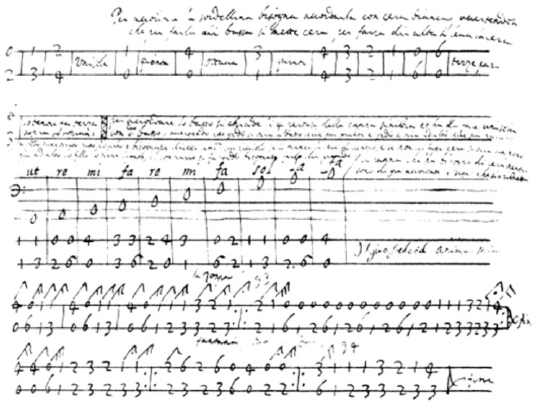
Figure 2.
Baldano’s page of tuning instructions provides the only detailed account of the tuning of the sordellina that has survived to the present day. In van der Meer’s reconstructed tuning system, a couple of errors are assumed in the tuning diagrams, which my approach seeks to avoid. While transcription of the tablature will still require a certain amount of artistic license (especially in the rhythmic values, which are often incomplete), my interpretation works for the entire page of tuning diagrams. Van der Meer suggests the tuning given in figure 3 for the sordellina:
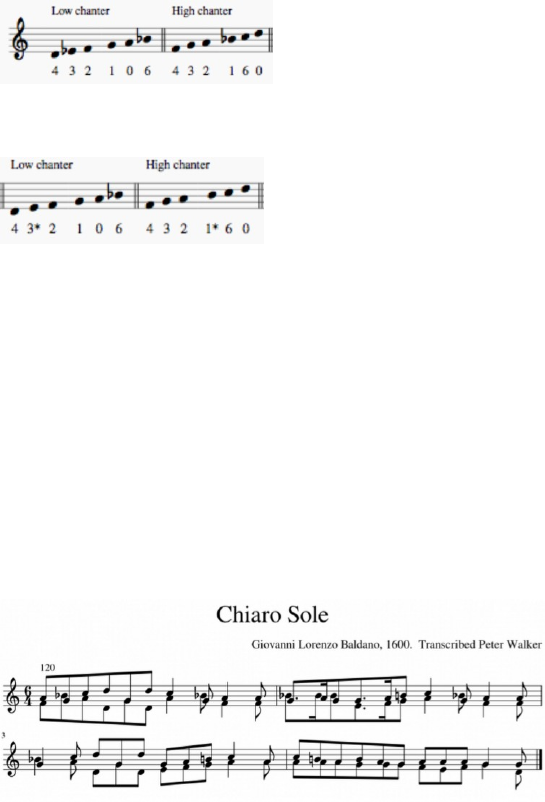
Figure 3.
The tuning system I propose differs from van der Meer’s on two notes, marked with an asterisk in figure 4:
Figure 4.
My reasons for suggesting these alternatives are as follows: E (3 on the low chanter) - this fingering is used with the bass note E in the figured bass diagram, and since that E is given the solmization syllable mi, it must have a half step above it, thus the Eb suggested by van der Meer is not possible, unless we assume either a missing flat (and the wrong solmization syllable) or a missing sign indicating the use of a key. B (1 on the high chanter) - once we have established that E is natural, this B must also be natural, since it forms a fifth with E in both the table of intervals and the figured bass diagram.
I have kept the Bb on the low chanter (6) as suggested by van der Meer, since it is often used in melodic phrases with F (2) on the same chanter, and otherwise would form an unlikely melodic tritone⁸. The presence of both Bb and B is very useful, and is supported by pieces which use the Bb on the low chanter while the high chanter plays a lower note. This crossing of voices makes sense if it allowed a shift of mode, otherwise the high chanter almost always plays above the lower chanter, as one would expect. When Bb and B are used in close proximity to one another, it is generally for melodic reasons, and each note leads where our ears expect, Bb down to a lower pitch, and B up to a higher one. The resulting alternation produces a very interesting and attractive musical effect. Figure 5 (previous page) is an example of this, and is a transcription of figure 1.
Figure 5
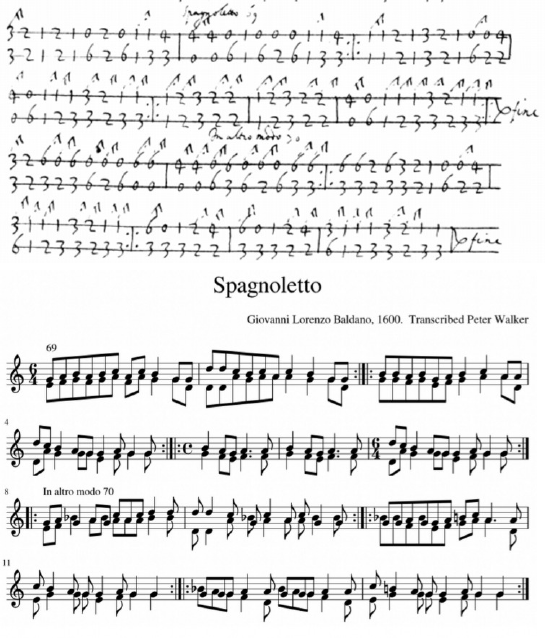
The presence of both B and Bb allows the sordellina to access both major and minor modes, as shown in pieces 69 and 70, a Spagnoletto and a variation in altro modo. These pieces are shown in tablature and transcription in figures 6 and 7.
Figure 7.

Further evidence for my suggested tuning can be found in the music theory of Baldano’s era. The proposed system allows the sordellina to play all the notes present in the musica recta (“true music”) system of medieval and renaissance music theory⁹. This system includes all the notes used in the Gregorian chant notation which formed the basis of theory until the advent of tonal harmony, and relegates all other intermediate pitches to musica ficta, or
“false music”. As Eric Montbel shows in his excellent articles on Manfredo Settala’s sordellina¹⁰, the instrument was often depicted as an instrument of learned polymaths, so it seems logical to find that it was constructed to adhere strictly to the principles of music theory.
While my approach produces a tuning system that gives a musically functional result from all of Baldano’s tablature, there is a complicating factor: some pieces in the collection (a bit less than 30%) include a gamma sign (Γ) below certain numbers, as shown in figure 8:
Figure 8.
Given the abundance of material in the manuscript without the Γ (over 100 pieces), understanding the Γ is not necessary in order to transcribe the majority of the music, but it must be deciphered if we are to play Baldano’s work in its entirety. This symbol does not occur in any other tablature from the period that I have been able to locate, and its meaning is unclear. Van der Meer interprets this sign as indicating a chanter key, used to change the pitch of the note in question by a semitone. This is a very reasonable assumption, given the prevalence of keys on the sordellina by at least 1630, in the portrait of Manfredo Settala described by O’Neill¹¹ and Montbel. However, I have not been able to work out a tuning system in which reading every Γ as a chanter key makes musical sense for the tablature, without requiring the assumption of errors in the interval table and figured bass diagram. A few hypothetical keys work well initially (most notably 2Γ on the low chanter‑this could indicate F#, and is often used cadentially with A on the high chanter, and 0Γ on the high chanter, which could indicate E or Eb, and is consistent with Mersenne’s depiction of the simple sordellina), but others cause problems. In #143 (shown in figure 8) the interval 3‑1Γ (E‑Bb, since 1 on the high chanter must be B natural to agree with the interval chart, thus a key must lower the pitch) suggests that all is not well. The line played by the high chanter in this same example casts further doubt on the key hypothesis: 36Γ1 (GC#B) is unusual, but 16Γ1Γ21Γ1621Γ6Γ22Γ is quite bizarre indeed! Figure 9 is a transcription of this line if we read Γ as a chanter key.

Figure 9.
Thus there does not appear to be an interpretation in which reading every Γ as an indication for a chanter key yields a musically functional result without assuming significant manuscript errors¹². Scribal errors are of course a possibility, but if one page in the manuscript were worthy of careful proofreading, it would be the page describing tuning procedure. Baldano could (and did) reasonably assume that the player might be able to fill in missing rhythmic indications in the music collection, not so on the page of tuning instructions. One could follow van der Meer and explain discrepancies between a proposed tuning system for keyed chanters and the table of intervals and figured bass diagram by suggesting that some of the notes on the tuning page should have been written with Γ below them, but anyone who has tried to tune a keyed note on a small bagpipe such as a musette de cour by partially covering the hole (difficult enough with tape, and all but impossible without removing the key if wax is used) will understand how unlikely it is that Baldano would have neglected to mention chanter keys, if they were used for the notes on the tuning diagram.
Thus, I would suggest that the tuning system outlined on Baldano’s page of tuning diagrams applies to the unkeyed sordellina mentioned in O’Neill¹³, which would have playedmusica recta, while the keys present on depictions from later in the 17th century (Mersenne describes the fully developed sordellina as having a key corresponding to every fingerhole)¹⁴ would add the option of playingmusica fictanotes. This leaves us with the problem of how to interpret the
Γ in Baldano’s tablature. While an examination of all the possible interpretations of the Γ is beyond the scope of the present paper, a potential solution is to read some or all of the uses of Γ as indicating notes played on a keyed bass pipe, similar to the regulators on the Irish uilleann pipes. Such bass pipes were a central feature of the elaborate keyed sordellina of the 1630s and later (the instrument reconstructed by Marco Tomassi), and perhaps Baldano’s instrument had a rudimentary version of this pipe. If (as suggested above) the tuning of the unkeyed sordellina is based onmusica recta, the lowest note of the theoretical system is indicated by Γ, called “gamma‑ut” and giving its name to thegamut, or scale. This note is the G at the bottom of the bass staff - and given that the music in Baldano’s tablature is all based around G, gamma-ut would make sense as a fundamental pitch for the regulator. Besides music theory, a visual reason may exist for the use of Γ as a symbol for notes played on the regulator. While Baldano used the uppercase gamma Γ, the gamma was also written as Ɣ. This bears a certain resemblance to the central keys present on later depictions of the sordellina, including the portrait of Manfredo Settala (c.1630) a detail of which is shown in figure 10.
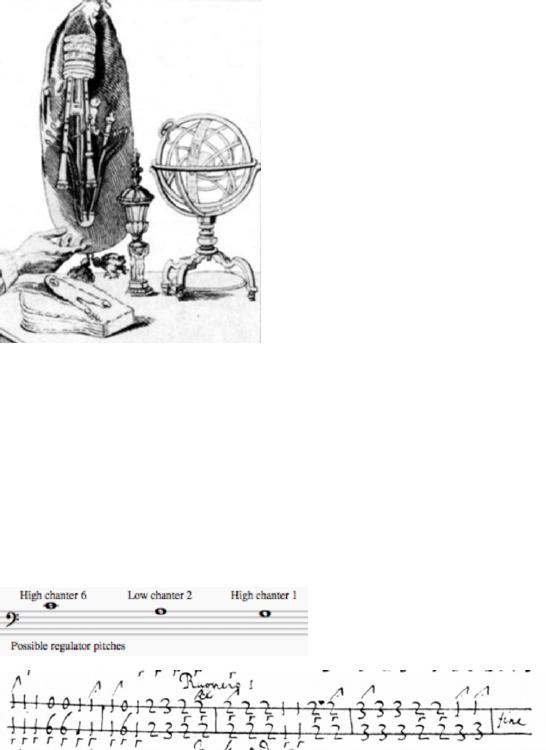
Without an extant instrument or any mention of the regulator on the pageof tuning instructions, the pitches played by this regulator (if it existed) must be inferred based on musical context. If Baldano’s sordellina had chanters with no (or only a few) keys, we can assume that it would likely have had a fairly simple regulator. Three keys (G and C generally indicated by 1Γ and 6Γ on the bottom line on the tablature, and A usually indicated by 2Γ on the upper line) would produce a musically useful layout. This hypothetical regulator tuning (as well as the most common chanter fingerings marked with each regulator pitch) is shown in figure 11, and the musical result of this hypothesis is shown in figures 12
(tablature) and 13.
Figure 11.
Figure 12.
Figure 10.
Manfredo Settala and his Sordellina, c.1630 (detail)
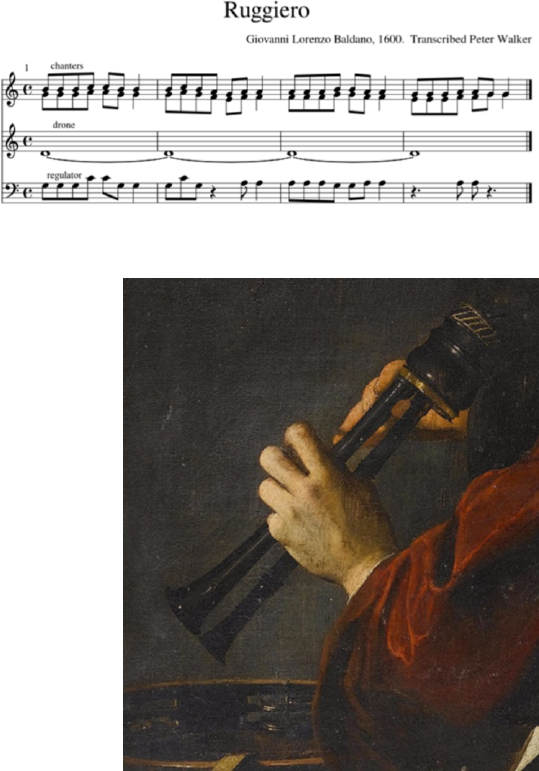
Figure 13.
Having arrived at a tuning system for the chanters and drone of the sordellina, and put the problem of the Γ aside pending further research and experimentation, the next step is to make a reconstruction of the instrument. Since Baldano’s manuscript contains no pictures and most later illustrations depict a fully keyed sordellina, we must find a model for this earlier instrument. I would suggest two potential examples. The first of these is an undated portrait of a young man holding an unkeyed sordellina, painted by Pietro Paolini (1603-1681), shown in figure 14. The instrument shown has two chanters and one drone, all of equal length. This suggests that the drone is probably tuned to the bottom D of the low chanter, as Baldano describes on the tuning page of his manuscript. The chanter stock is rather large for the pipes shown, perhaps more drones or a regulator could be added if desired.
Figure 14. Detail from a painting by Pietro Paolini (1603-1681)

The second, and more detailed of the two examples can be found in the Golden Harpsichord of Michele Todini, displayed at the Metropolitan Museum of Art in New York City¹⁵, and shown on the back cover. This magnificent musical machine includes a sculpture of the cyclops Polyphemus (unrequited lover of Galatea in Ovid’s Metamorphoses), with his “pipes made of a hundred reeds” described by Ovid¹⁶ updated from a bucolic panpipe to a sordellina. This instrument has four pipes: two chanters of equal length, a drone the same length as the chanters, and a long pipe which doubles back on itself. This looks nearly identical to the regulator shown in later depictions of the sordellina, but no keys are present. One could argue that they were left off for ease of carving, but given the level of detail present in the rest of the sculpture (down to the inlet hole in the bellows, details of turning on the chanters and drones, and even the fringe around the neck of the bag and the folds of leather in the bellows), I think it is reasonable to assume that if keys were present, the artist would likely have shown them. That said, it is certainly possible that the complicated keywork of the sordellina could have been omitted for artistic or practical reasons. As in Paoli’s painting, the drone of equal length with the chanter must sound D, in unison with the lowest note of the lower chanter. The low drone (assuming that the sculpture accurately depicts a drone, rather than a regulator with keys omitted) could either sound an octave below that D, or perhaps G a fifth below the chanter D. Given that the music in Baldano’s manuscript shows a strong preference for G, a G drone would be a useful choice. Possible drone pitches are shown in figure 15.
Figure 15.
It is my hope that the tuning system proposed in this paper might contribute to the further understanding of the early history of the sordellina, and shed more light on this still-mysterious instrument and its repertoire. While the tuning system is a starting point, much remains to be done. At the time of publication, I am working with pipemaker Mike MacNintch to attempt a reconstruction of Baldano’s sordellina, and once it is completed playing through the book of tablature ought to shed more light on how the instrument functioned in practice. Practical experience with the instrument should also provide insight into possible interpretations of the Γ, suggest approaches to fingering and ornamentation for the music in the manuscript, and inform further interpretation and transcription of the repertoire. This will be the subject of a future article.
**Acknowledgements:
**With thanks to Dr. John K. Cox and Dr. Christa Patton for critiques and musicological insight, to Sarah Walker for editing, and to Mike MacNintch for expertise in piping and pipemaking.
- https://data.bnf.fr/16500488/giovanni_lorenzo_baldano/
- Wilbourne, Emily. Seventeenth-Century Opera and the Sound of the Commedia dell’Arte, Chicago, 2016. p.123
- Grimm, Horst. *Il Libro della Sordellina. *Compact Disc recording, Verlag der Spielleute, #9903, 1999
- A video of this reconstruction may be seen at the following link: https://www.facebook.com/LiuteriaMontecassino/posts/1238580879644570?sfnsw=cl
- Mersenne, Marin. Harmonie Universelle. Livre Cinquiesme, p.293-294. Paris, 1636
- Giovanni Lorenzo Baldano. Libro Per Scriver L’Intavolatura per Sonare sopra le Sordelline. (Tablature Book for Playing the Sordellina). Savona, 1600, facsimile published by the Associazione Ligure per la Ricerca delle Fonti Musicali, Savona, 1995.
- van der Meer, John Henry. La sordellina: Organologia e tecnica esecutiva. 73-105 in Baldano (1995)
- The other possible solution to this problem would be to raise the Fs to F# (they must be the same note, since 2-4 is listed as a unison on the table of intervals), but this would also require that we assume an error in both the written F and the solmization syllable on the figured bass diagram.
- For an excellent discussion of music theory of the Middle Ages and Renaissance, see Mahrt, William P. “Gamut, Solmization, & Modes” and Cross, Lucy E. “Musica Ficta” in*A Performer’s Guide to Medieval Music, *ed. Duffin, Ross. Bloomington, 2000
- Montbel, Eric “The Sourdeline of Manfredo Settala, a Milanese inventor in 1640, Part 1*.” Chanter*, Summer 2015, and Montbel, Eric “The Sourdeline of Manfredo Settala, a Milanese inventor in 1640, Part 2*.” Chanter*, Autumn 2015.
- O’Neill, Barry “The Sordellina, a Possible Origin of the Irish Regulators.” The Seán Reid Society Journal. Volume 2. March 2002
- For example, changing high chanter 1 to Bb, so that 1Γ indicates B natural would fix some of the melodic problems indicated above, but sets us on a slippery slope of assumptions: we must also change low chanter 3 to Eb to maintain the fifth 3-1 on the interval table, and while this would fix 3- 0Γ, we would also have to assume Eb for the E clearly marked asmi (as stated previously, the solmization syllablemiindicates a leading tone with a half step above it) on the figured bass diagram, and 3‑1Γ would no longer be consonant.
- O’Neill, p.9
- Mersenne, p.294
- Powers, Wendy “The Golden Harpsichord of Michele Todini” http://bit.ly/Chanter71
- Ovid “Metamorphoses”, Book XIII, line 784
- Data Processing Notice (GDPR)
@BagpipeSociety on X (formally known as Twitter)
TheBagpipeSociety on Instagram
 BagpipeSociety on Facebook
BagpipeSociety on Facebook
Something wrong or missing from this page? Let us know!
